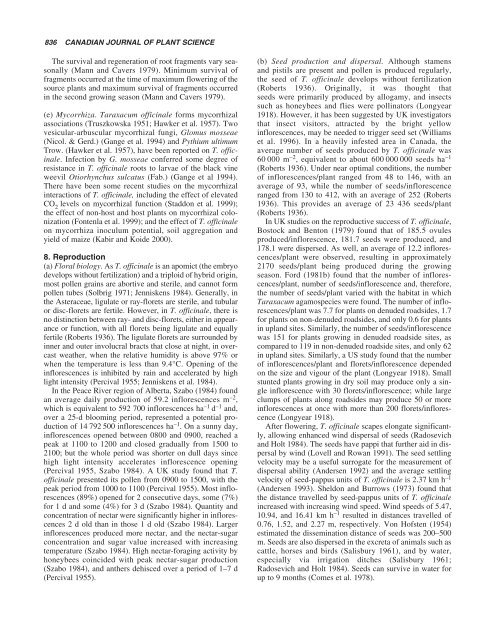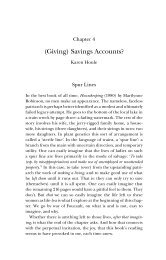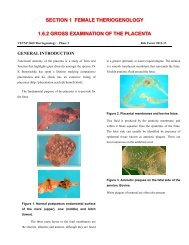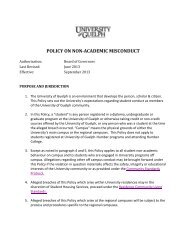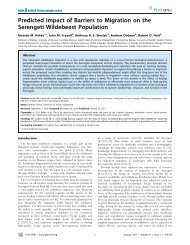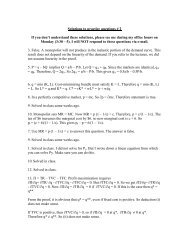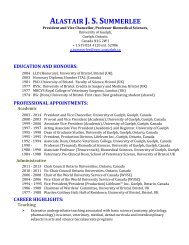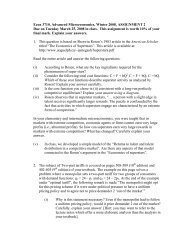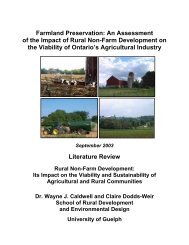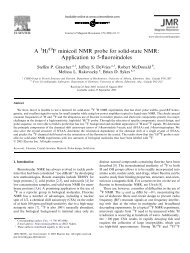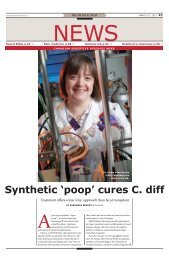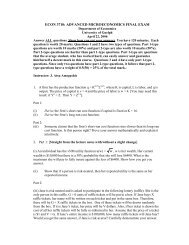The biology of Canadian weeds. 117. Taraxacum officinale G. H. ...
The biology of Canadian weeds. 117. Taraxacum officinale G. H. ...
The biology of Canadian weeds. 117. Taraxacum officinale G. H. ...
You also want an ePaper? Increase the reach of your titles
YUMPU automatically turns print PDFs into web optimized ePapers that Google loves.
836 CANADIAN JOURNAL OF PLANT SCIENCE<br />
<strong>The</strong> survival and regeneration <strong>of</strong> root fragments vary seasonally<br />
(Mann and Cavers 1979). Minimum survival <strong>of</strong><br />
fragments occurred at the time <strong>of</strong> maximum flowering <strong>of</strong> the<br />
source plants and maximum survival <strong>of</strong> fragments occurred<br />
in the second growing season (Mann and Cavers 1979).<br />
(e) Mycorrhiza. <strong>Taraxacum</strong> <strong>of</strong>ficinale forms mycorrhizal<br />
associations (Truszkowska 1951; Hawker et al. 1957). Two<br />
vesicular-arbuscular mycorrhizal fungi, Glomus mosseae<br />
(Nicol. & Gerd.) (Gange et al. 1994) and Pythium ultimum<br />
Trow. (Hawker et al. 1957), have been reported on T. <strong>of</strong>ficinale.<br />
Infection by G. mosseae conferred some degree <strong>of</strong><br />
resistance in T. <strong>of</strong>ficinale roots to larvae <strong>of</strong> the black vine<br />
weevil Otiorhynchus sulcatus (Fab.) (Gange et al 1994).<br />
<strong>The</strong>re have been some recent studies on the mycorrhizal<br />
interactions <strong>of</strong> T. <strong>of</strong>ficinale, including the effect <strong>of</strong> elevated<br />
CO 2 levels on mycorrhizal function (Staddon et al. 1999);<br />
the effect <strong>of</strong> non-host and host plants on mycorrhizal colonization<br />
(Fontenla et al. 1999); and the effect <strong>of</strong> T. <strong>of</strong>ficinale<br />
on mycorrhiza inoculum potential, soil aggregation and<br />
yield <strong>of</strong> maize (Kabir and Koide 2000).<br />
8. Reproduction<br />
(a) Floral <strong>biology</strong>. As T. <strong>of</strong>ficinale is an apomict (the embryo<br />
develops without fertilization) and a triploid <strong>of</strong> hybrid origin,<br />
most pollen grains are abortive and sterile, and cannot form<br />
pollen tubes (Solbrig 1971; Jenniskens 1984). Generally, in<br />
the Asteraceae, ligulate or ray-florets are sterile, and tubular<br />
or disc-florets are fertile. However, in T. <strong>of</strong>ficinale, there is<br />
no distinction between ray- and disc-florets, either in appearance<br />
or function, with all florets being ligulate and equally<br />
fertile (Roberts 1936). <strong>The</strong> ligulate florets are surrounded by<br />
inner and outer involucral bracts that close at night, in overcast<br />
weather, when the relative humidity is above 97% or<br />
when the temperature is less than 9.4°C. Opening <strong>of</strong> the<br />
inflorescences is inhibited by rain and accelerated by high<br />
light intensity (Percival 1955; Jenniskens et al. 1984).<br />
In the Peace River region <strong>of</strong> Alberta, Szabo (1984) found<br />
an average daily production <strong>of</strong> 59.2 inflorescences m –2 ,<br />
which is equivalent to 592 700 inflorescences ha –1 d –1 and,<br />
over a 25-d blooming period, represented a potential production<br />
<strong>of</strong> 14 792 500 inflorescences ha –1 . On a sunny day,<br />
inflorescences opened between 0800 and 0900, reached a<br />
peak at 1100 to 1200 and closed gradually from 1500 to<br />
2100; but the whole period was shorter on dull days since<br />
high light intensity accelerates inflorescence opening<br />
(Percival 1955, Szabo 1984). A UK study found that T.<br />
<strong>of</strong>ficinale presented its pollen from 0900 to 1500, with the<br />
peak period from 1000 to 1100 (Percival 1955). Most inflorescences<br />
(89%) opened for 2 consecutive days, some (7%)<br />
for 1 d and some (4%) for 3 d (Szabo 1984). Quantity and<br />
concentration <strong>of</strong> nectar were significantly higher in inflorescences<br />
2 d old than in those 1 d old (Szabo 1984). Larger<br />
inflorescences produced more nectar, and the nectar-sugar<br />
concentration and sugar value increased with increasing<br />
temperature (Szabo 1984). High nectar-foraging activity by<br />
honeybees coincided with peak nectar-sugar production<br />
(Szabo 1984), and anthers dehisced over a period <strong>of</strong> 1–7 d<br />
(Percival 1955).<br />
(b) Seed production and dispersal. Although stamens<br />
and pistils are present and pollen is produced regularly,<br />
the seed <strong>of</strong> T. <strong>of</strong>ficinale develops without fertilization<br />
(Roberts 1936). Originally, it was thought that<br />
seeds were primarily produced by allogamy, and insects<br />
such as honeybees and flies were pollinators (Longyear<br />
1918). However, it has been suggested by UK investigators<br />
that insect visitors, attracted by the bright yellow<br />
inflorescences, may be needed to trigger seed set (Williams<br />
et al. 1996). In a heavily infested area in Canada, the<br />
average number <strong>of</strong> seeds produced by T. <strong>of</strong>ficinale was<br />
60 000 m –2 , equivalent to about 600 000 000 seeds ha –1<br />
(Roberts 1936). Under near optimal conditions, the number<br />
<strong>of</strong> inflorescences/plant ranged from 48 to 146, with an<br />
average <strong>of</strong> 93, while the number <strong>of</strong> seeds/inflorescence<br />
ranged from 130 to 412, with an average <strong>of</strong> 252 (Roberts<br />
1936). This provides an average <strong>of</strong> 23 436 seeds/plant<br />
(Roberts 1936).<br />
In UK studies on the reproductive success <strong>of</strong> T. <strong>of</strong>ficinale,<br />
Bostock and Benton (1979) found that <strong>of</strong> 185.5 ovules<br />
produced/inflorescence, 181.7 seeds were produced, and<br />
178.1 were dispersed. As well, an average <strong>of</strong> 12.2 inflorescences/plant<br />
were observed, resulting in approximately<br />
2170 seeds/plant being produced during the growing<br />
season. Ford (1981b) found that the number <strong>of</strong> inflorescences/plant,<br />
number <strong>of</strong> seeds/inflorescence and, therefore,<br />
the number <strong>of</strong> seeds/plant varied with the habitat in which<br />
<strong>Taraxacum</strong> agamospecies were found. <strong>The</strong> number <strong>of</strong> inflorescences/plant<br />
was 7.7 for plants on denuded roadsides, 1.7<br />
for plants on non-denuded roadsides, and only 0.6 for plants<br />
in upland sites. Similarly, the number <strong>of</strong> seeds/inflorescence<br />
was 151 for plants growing in denuded roadside sites, as<br />
compared to 119 in non-denuded roadside sites, and only 62<br />
in upland sites. Similarly, a US study found that the number<br />
<strong>of</strong> inflorescences/plant and florets/inflorescence depended<br />
on the size and vigour <strong>of</strong> the plant (Longyear 1918). Small<br />
stunted plants growing in dry soil may produce only a single<br />
inflorescence with 30 florets/inflorescence; while large<br />
clumps <strong>of</strong> plants along roadsides may produce 50 or more<br />
inflorescences at once with more than 200 florets/inflorescence<br />
(Longyear 1918).<br />
After flowering, T. <strong>of</strong>ficinale scapes elongate significantly,<br />
allowing enhanced wind dispersal <strong>of</strong> seeds (Radosevich<br />
and Holt 1984). <strong>The</strong> seeds have pappi that further aid in dispersal<br />
by wind (Lovell and Rowan 1991). <strong>The</strong> seed settling<br />
velocity may be a useful surrogate for the measurement <strong>of</strong><br />
dispersal ability (Andersen 1992) and the average settling<br />
velocity <strong>of</strong> seed-pappus units <strong>of</strong> T. <strong>of</strong>ficinale is 2.37 km h –1<br />
(Andersen 1993). Sheldon and Burrows (1973) found that<br />
the distance travelled by seed-pappus units <strong>of</strong> T. <strong>of</strong>ficinale<br />
increased with increasing wind speed. Wind speeds <strong>of</strong> 5.47,<br />
10.94, and 16.41 km h –1 resulted in distances travelled <strong>of</strong><br />
0.76, 1.52, and 2.27 m, respectively. Von H<strong>of</strong>sten (1954)<br />
estimated the dissemination distance <strong>of</strong> seeds was 200–500<br />
m. Seeds are also dispersed in the excreta <strong>of</strong> animals such as<br />
cattle, horses and birds (Salisbury 1961), and by water,<br />
especially via irrigation ditches (Salisbury 1961;<br />
Radosevich and Holt 1984). Seeds can survive in water for<br />
up to 9 months (Comes et al. 1978).


